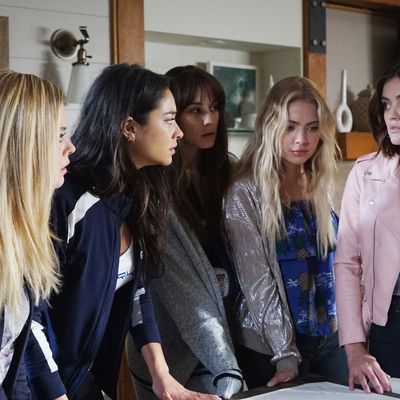
This week, after seven seasons and 160 episodes, Pretty Little Liars concluded with an utterly bananas finale. The two-hour send-off was a spectacle that brought back old characters, introduced a brand-new one to answer the show’s biggest mystery, and still resolved everything in time for Spencer, Aria, Hanna, Alison, and Emily to hug it out and say good-bye on the streets of Rosewood.
If, for some reason, you decided to check into PLL for the first and only time during its final hours, your head might have spun clean off your shoulders. What is this? How has this stayed on the air for so long? But for the Liars faithful, it was an all-too-logical conclusion of a show that suspended disbelief so fully that it gave itself permission to do almost anything. By the time it reached its endgame, PLL could pull off whatever showrunner I. Marlene King dreamed up without fans seeing it as too far afield.
Consider this: In the series finale, it turned out that the final boss, known as A.D., was the heretofore unknown evil twin sister of one of the main characters, Spencer Hastings. The grand plan of Alex Drake — who also spoke with an Amy Winehouse–esque British accent because she was raised in the U.K. — was to assume Spencer’s identity and keep her prisoner forever in an underground bunker. The prison had the façade of a house with a yard and everything, but that house wasn’t real; it was a false front within a Truman Show–style containment facility that even simulated day and night. All of this was built within the town of Rosewood without anyone noticing, and paid for by two women living on the outside of the law. It sounds insane because it is, but it existed within the realm of normalcy established on Pretty Little Liars. Soap operas work decades to build mythologies this dense, and the crown jewel of Freeform pulled it off in a single episode.
PLL began as a Gossip Girl–meets–Nancy Drew murder mystery about four high-school juniors trying to figure out who killed their frenemy, but it truly found its footing when it became a tangled whodunit that Homeland’s Carrie Mathison would need a football-field-size yarn chart to track. The deviousness of the show’s villains, a succession of foes who go by the handle “A,” knew no bounds: First the Liars were blackmailed with embarrassing secrets, then they had a high-school fashion show sabotaged, and before long, one of them was trapped in a wooden box with a dead body and almost thrown off the side of a moving train.
The biggest test of this “anything goes” mentality came during PLL’s season-five finale, “Welcome to the Dollhouse.” While in police custody, the four Liars are kidnapped and taken to a subterranean prison with jail cells modeled as exact re-creations of their bedrooms. They’re physically and psychologically tortured for weeks, and even tasked with creating a creepy parallel-universe prom. The girls are eventually rescued, and halfway into season six they finally discover the identity of their attacker: It was Charlotte Drake, the trans cousin of their frenemy Alison, who wasn’t actually dead after all. A genius hell-bent on regaining the life that was stolen from her while she was shut away in a sanitarium, Charlotte was the mastermind behind the Dollhouse — and naturally, a mastermind needs a command center from which to control her vast dark empire. Right there, smack dab in the middle of Rosewood, the girls discover a hidden control room equipped with capacitive interface screens and a hologram display. In their elaborate prom dresses, the Liars suddenly find themselves in Minority Report, and even as they’re horrified, none of them question the fact of its existence.
If PLL were any other show, this would be the moment when it jumped the shark, but King and her writers flipped that concept by throwing a saddle on the back of the shark, strapping rockets to its fins, putting a party hat on its head, and riding it through the surf. Again and again, the reach of A’s wealth and technological know-how proved limitless, and the escalation from ominous text messages to the presence of a full-on surveillance state within Rosewood was gradual enough to keep the majority of viewers hooked. The PLL writing staff took “You’ve really outdone yourself” as more of a challenge than a critique, and it freed up the show to stay exciting despite constantly working to solve the central mystery: Who is A?
From the madness sprang a unique kind of genius: By steadily leveling up the absurdity throughout its seven years, PLL crazy-proofed itself. The primary problem with any murder mystery is that you have to solve the puzzle at some point. You have to unmask the killer, but that means dissolving the entire conceit of the show. The first season of Twin Peaks ensnared America. Viewers became obsessed with figuring out who killed Laura Palmer. But once that iconic question was answered, the show fell out of favor as it turned from a palatable crime drama into a Lynchian study of a quirky town in the Pacific Northwest. The American adaptation of The Killing made a splash in its first season, but struggled to keep people engaged when the case of Rosie Larsen bled into season two. When the murder was finally solved, The Killing was cancelled (twice!) before jumping to Netflix to close out its four-season run.
King is a noted Twin Peaks fan, and she cited the show as a primary inspiration for PLL. One big thing she told Vulture she learned from it: “People love to keep guessing and guessing.” That’s true, and audience speculation in this day and age leads to social-media gold. Although some early PLL fans walked away from the show when it exited the realm of belief, enough stuck around to make the finale the most-tweeted-about episode of television so far this year, an appropriate feat when you consider that PLL pioneered the two-screen viewing culture we live in today.
Actress Troian Bellisario, who played both Spencer and her evil twin, Alex, told Vulture that producers initially talked about the show’s audience in terms of social impressions instead of ratings, and just last year, a ListenFirst Media study named PLL the most social show on TV, surpassing its next-closest competitor by more than 100 million impressions. That’s impressive by any measure, and it proved that viewers couldn’t get enough of Freeform’s ever-more-soapy drama about crime-solving and the power of female friendships.
Once the PLL audience got comfortable with ideas like a teenage girl being nearly sawed in half, or a car being smashed into her living room, they became conditioned to expect the extreme. When you forcibly sedate a character and inseminate her with her best friend’s eggs after those eggs were stolen from a fertility clinic — and you have the whole thing orchestrated by the newly pregnant girl’s imposter husband, who is neither in love with her nor a doctor at all — then you’ve conditioned your audience to expect the impossible. After that, the only stipulation is that you never hold back, and Pretty Little Liars never did.


